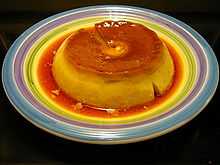Caramel
| Caramel | |
|---|---|
 A saucer of liquid caramel | |
| Course | Dessert |
| Main ingredients | Sugar |
| Variations | brittles, nougats, pralines, crème brûlée, crème caramel, and caramel apple |
|
| |

Caramel (/ˈkærəmɛl/ or /ˈkɑrməl/[1][2]) is a beige to dark-brown confectionery product made by heating any of a variety of sugars. It is used:
- as a flavoring in puddings and desserts
- as a filling in bonbons
- as a topping for ice cream and custard
The process of caramelization consists of heating sugar slowly to around 170 °C (340 °F). As the sugar heats, the molecules break down and re-form into compounds with a characteristic color and flavor.
A variety of candies, desserts, and confections are made with caramel: brittles, nougats, pralines, crème brûlée, crème caramel, and caramel apples. Ice creams sometimes are flavored with or contain swirls of caramel.[3]
Etymology
The origin of the word has been traced to Medieval Latin cannamellis (sugar cane) and to Latin callamellus (little reed, referring to sugar cane).
Caramel sauce

Caramel sauce is made by heating water and caster sugar (also called superfine sugar) at a low to moderate temperature until the sugar dissolves and "caramelizes," changing color to golden brown.

Caramel candy
Caramel candy is a soft, dense, chewy candy made by boiling a mixture of milk or cream, sugar(s), butter, and vanilla flavoring. The sugar(s) are heated separately to reach 170 °C (340 °F), caramelizing them before the other ingredients are added.[4] Alternatively, all ingredients may be cooked together; in this procedure, the mixture is not heated above the firm ball stage (120 °C (250 °F)), so that caramelization of the milk occurs but not caramelization of the sugars. This type of candy is often called milk caramel or cream caramel.
Caramel coloring
Caramel coloring, a dark, bitter-tasting liquid, is the highly concentrated product of near total caramelization, bottled for commercial use. It is used as food coloring and in beverages such as cola.
Chemistry
Caramelization is the removal of water from a sugar, proceeding to isomerization and polymerization of the sugars into various high-molecular-weight compounds. Compounds such as difructose anhydride may be created from the monosaccharides after water loss. Fragmentation reactions result in low-molecular-weight compounds that may be volatile and may contribute to flavor. Polymerization reactions lead to larger-molecular-weight compounds that contribute to the dark-brown color.[5]
In modern recipes and in commercial production, glucose (from corn syrup or wheat) or invert sugar is added to prevent crystallization, making up 10%–50% of the sugars by mass. "Wet caramels" made by heating sucrose and water instead of sucrose alone produce their own invert sugar due to thermal reaction, but not necessarily enough to prevent crystallization in traditional recipes.[6]
Nutritional information
Two tablespoons (i.e., 41 grams) of commercially prepared butterscotch or caramel topping contain:[7]
- Calories (kcal): 103
- Protein (g): 0.62
- Total lipids (fat): 0.04
- Carbohydrates, by difference (g): 27.02
- Fiber, total dietary (g): 0.4
- Cholesterol (mg): 0.0
See also
- Cadbury Dairy Milk Caramel, a British brand of caramel chocolate bar
- Caramac, a British brand of caramel candy bar
- Carambar, a French brand of caramel candy bar
- Caramel corn, popcorn coated in caramel
- Caramilk, a Canadian brand of caramel chocolate bar
- Confiture de lait, caramelized, sweetened milk
- Dodol, a caramelized confection made with coconut milk
- Dulce de leche, caramelized, sweetened milk
- Maillard reaction
- Tablet (confectionery), Scottish candy made with condensed milk
- Toffee, a type of candy
References
- ↑ New Oxford American Dictionary (3rd ed.). New York: Oxford University Press. 2010. p. 260.
- ↑ The American Heritage Dictionary of the English Language (5th ed.). Boston: Houghton Mifflin Harcourt. 2011. p. 278.
- ↑ CondeNet. "Salted Caramel Ice Cream". Epicurious.
- ↑ "Ready for Dessert". google.com.
- ↑ Caramelization, retrieved 2009-05-07
- ↑ "6. Sugar confectionery". Fao.org. Retrieved 2013-01-01.
- ↑ "Nutrient data for 19364, Toppings, butterscotch or caramel". National Nutrient Database for Standard Reference. USDA, ARS, NAL, Nutrient Data Laboratory.
External links
| Wikibooks Cookbook has a recipe/module on |
 Media related to Caramel at Wikimedia Commons
Media related to Caramel at Wikimedia Commons